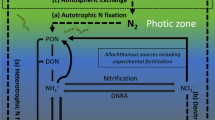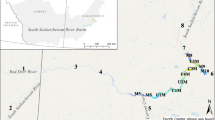Abstract
Reservoir hydrodynamics may create heterogeneity in nitrogen (N) fixation along the riverine–transition–lacustrine gradient. In particular, N fixation may be highest in reservoir transition zones where phytoplankton biomass is also expected to be relatively high. We investigated spatial patterns of N fixation in three Texas (USA) reservoirs of varying trophic state. We sampled 6–9 stations along the longitudinal axes of the major inflows and measured N fixation using the acetylene reduction method. Total N, total phosphorus (P), and algal biomass (as chlorophyll-a) were also measured at each sample location. Measurable N fixation was observed in all reservoirs and was light-dependent. Nitrogen fixation was consistently low in the riverine zone, highest in the transition zone, and low in lacustrine zone of all reservoirs. The absolute magnitude of N fixation was similar in two relatively unproductive reservoirs and an order of magnitude higher in the eutrophic reservoir. A similar pattern was observed in mean nutrient and chlorophyll-a concentrations among reservoirs. However, chlorophyll-a concentrations were highest in the riverine zone of each reservoir and exhibited a monotonic decrease in the downstream direction. Maximum chlorophyll-a concentrations did not coincide with maximum N fixation rates. Results of our study indicate that reservoir transition zones can be biogeochemical hot spots for planktonic N fixation, regardless of trophic state. Therefore, transition zones may be the most at risk locations for water quality degradation associated with increased reservoir productivity. Water quality managers and aquatic scientists should consider the spatial heterogeneity imposed by unique hydrodynamic controls in reservoir ecosystems.



Similar content being viewed by others
References
APHA (American Public Health Association), 1998. Standard Methods for the Examination of Water and Wastewater, 20th ed. APHA and the American Public Health Association, Washington, DC, USA.
Bukaveckas, P. A. & A. S. Crain, 2002. Inter-annual, seasonal, and spatial variability in nutrient limitation of phytoplankton production in a river impoundment. Hydrobiologia 481: 19–31.
David, M. B., L. G. Wall, T. V. Royer & J. L. Tank, 2006. Denitrification and the nitrogen budget of a reservoir in an agricultural landscape. Ecological Applications 16: 2177–2190.
Dean, W. E. & E. Gorham, 1998. Magnitude and significance of carbon burial in lakes, reservoirs, and peatlands. Geology 26: 535–538.
Downing, J. A. & E. McCauley, 1992. The nitrogen:phosphorus ratio in lakes. Limnology and Oceanography 37: 936–945.
Flett, R. J., R. D. Hamilton & N. E. R. Campbell, 1976. Aquatic acetylene reduction techniques: solutions to several problems. Canadian Journal of Microbiology 22: 43–51.
Forbes, M. G., R. D. Doyle, J. T. Scott, J. K. Stanley, H. Huang & B. W. Brooks, 2008. Physical factors control phytoplankton production and N2 fixation in eight Texas reservoirs. Ecosystems 11: 1181–1197.
Hejzlar, J., K. Šámalová, P. Boers & B. Kronvang, 2007. Modelling phosphorus retention in lakes and reservoirs. In Kronvang, B., J. Faganeli & N. Ogrinc (eds), The Interactions Between Sediment and Water. Springer, New York: 123–130.
Howarth, R. W., R. Marino, J. Lane & J. J. Cole, 1988. Nitrogen fixation in freshwater, estuarine, and marine ecosystems. 1. Rates and importance. Limnology and Oceanography 33: 669–687.
Kalff, J., 2002. Limnology. Prentice Hall, Upper Saddle River, NJ, USA.
Kennedy, R. H., J. G. Tundisi, V. Straškrábová, O. T. Lind & J. Hejzlar, 2003. Reservoirs and the limnologist’s growing role in sustainable water resource management. Hydrobiologia 504: xi–xii.
Kimmel, B. L. & A. W. Groeger, 1984. Factors controlling primary production in lakes and reservoirs. In Lake and Reservoir Management. Proc. North American Lake Management Society Symposium. EPA 440/5/84-001. U.S.E.P.A., Washington DC: 277–281, 604 pp.
Kimmel, B. L., O. T. Lind & L. J. Paulson, 1990. Reservoir primary production. In Thornton, K. W., B. L. Kimmel & F. E. Payne (eds), Reservoir Limnology: Ecological Perspectives. Wiley, New York.
Kolber, Z. S., 2006. Getting a better picture of the ocean’s nitrogen budget. Science 312: 1479–1480.
Levine, S. N. & D. W. Schindler, 1999. Influence of nitrogen to phosphorus supply ratios and physicochemical conditions on cyanobacteria and phytoplankton species composition in the Experimental Lakes Area, Canada. Canadian Journal of Fisheries and Aquatic Science 56: 451–466.
Lind, O. T., T. T. Terrell & B. L. Kimmel, 1993. Problems in reservoir trophic-state classification and implications for reservoir management. In Straskraba, M., J. G. Tundisi & A. Duncan (eds), Comparative Reservoir Limnology and Water Quality Management. Kluwer, Netherlands: 57–67.
Nowlin, W. H., J. L. Evarts & M. J. Vanni, 2005. Release rates and potential fates of nitrogen and phosphorus from sediments in a eutrophic reservoir. Freshwater Biology 50: 301–322.
Reynolds, C. S., 1972. Growth, gas vacuolation and buoyancy in natural populations of blue-green alga. Freshwater Biology 2: 87–106.
Schindler, D. W., 1977. Evolution of phosphorus limitation in lakes. Science 46: 260–262.
Scott, J. T., R. D. Doyle & C. T. Filstrup, 2005. Periphyton nutrient limitation and nitrogen fixation potential along a wetland nutrient-depletion gradient. Wetlands 25: 439–448.
Scott, J. T., R. D. Doyle, J. A. Back & S. I. Dworkin, 2007. The role of N2 fixation in alleviating N limitation in wetland metaphyton: enzymatic, isotopic, and elemental evidence. Biogeochemistry 84: 207–218.
Scott, J. T., R. D. Doyle, S. J. Prochnow & J. D. White, 2008a. Are watershed and lacustrine controls on planktonic N2 fixation hierarchichally structured? Ecological Applications 18: 805–819.
Scott, J. T., M. J. McCarthy, W. S. Gardner & R. D. Doyle, 2008b. Denitrification, dissimilatory nitrate reduction to ammonium, and nitrogen fixation along a nitrate concentration gradient in a created freshwater wetland. Biogeochemistry 87: 99–111.
Sen, S., B. E. Haggard, I. Chaubey, K. R. Brye, T. A. Costello & M. D. Matlock, 2007. Sediment phosphorus release at Beaver Reservoir, Northwest Arkansas, USA, 2002–2003; a preliminary investigation. Water, Air and Soil Pollution 179: 67–77.
Smith, V. H., 1983. Low nitrogen to phosphorus ratios favor dominance by blue-green algae in lake phytoplankton. Science 221: 669–671.
TCEQ (Texas Commission on Environmental Quality), 2007. Surface Water Quality Monitoring. Monitoring and Operations Division, TCEQ, Austin, Texas. Available from http://www.tceq.state.tx.us/assets/public/compliance/monops/water/wdma/dmrg/2007/2007dmrg_complete.pdf.
TIAER (Texas Institute for Applied Environmental Research), 2007. Semi-annual Water Quality Report for the North Bosque River Watershed. TIAER, Stephenville, Texas. Available from: http://tiaerweb.tarleton.edu/pdf/TR0601.pdf.
Thornton, K. W., B. L. Kimmel & F. E. Payne (eds), 1990. Reservoir limnology: ecological perspectives. Wiley, New York.
Tomaszek, J. A. & P. Koszelnik, 2003. A simple model of N retention in reservoirs. Hydrobiologia 504: 51–58.
USGS (United States Geological Survey), 2005a. Water-Data Report TX-2005; 08103800 Lampasas River near Kempner, TX. USGS-Texas, Austin, Texas. Available from http://waterdata.usgs.gov/nwis/nwisman/?site_no=08103800.
USGS (United States Geological Survey), 2005b. Water-Data Report TX-2005; 08167500 Guadalupe River near Spring Branch, TX. USGS-Texas, Austin, Texas. Available from http://waterdata.usgs.gov/nwis/nwisman/?site_no=08167500.
USGS (United States Geological Survey), 2005c. Water-Data Report TX-2005; 08095200 North Bosque River at Valley Mills, TX. USGS-Texas, Austin, Texas. Available from http://waterdata.usgs.gov/nwis/nwisman/?site_no=08095200.
Wetzel, R. G., 2001. Limnology: Lake and River Ecosystems, 3rd ed. Academic Press, San Diego, CA, USA.
Acknowledgments
This work was supported by a grant from the City of Waco to R. Doyle and from the Texas Commission on Environmental Quality (TCEQ) to B. Brooks and R. Doyle. The Texas Institute for Applied Environmental Research (TIAER) and TCEQ provided long-term nitrate concentration data on reservoirs. The authors thank S. Williams, E. Martin, and B. Fulton for their assistance with field and laboratory efforts.
Author information
Authors and Affiliations
Corresponding author
Additional information
Handling editor: Luigi Naselli-Flores
Rights and permissions
About this article
Cite this article
Scott, J.T., Stanley, J.K., Doyle, R.D. et al. River–reservoir transition zones are nitrogen fixation hot spots regardless of ecosystem trophic state. Hydrobiologia 625, 61–68 (2009). https://doi.org/10.1007/s10750-008-9696-2
Received:
Revised:
Accepted:
Published:
Issue Date:
DOI: https://doi.org/10.1007/s10750-008-9696-2




